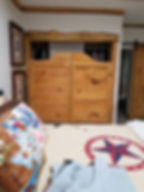Creative Carpentry for a Cowboy Room
- Matt Weber
- Jul 27, 2021
- 2 min read
Updated: Aug 18, 2022

Wood lovers might love the unique “Old West” accents that Randy Stephenson of Cropwell, Alabama, made from rough-cut lumber for a cowboy-theme room at his home. By incorporating the exposed wood grain and natural live edges into the baseboards, ceiling molding, and door and window casing, he gave the room an old-timey feel which he enhanced with a pair of batwing-style saloon doors.
"My wife Donna came up with the design of the room," explains Stephenson. "She is the brains, and I'm just the grunt."
Enclosing a closet, the saloon doors were comprised of edge-joined boards enclosed by a four-piece rail-and-stile frame. To give the doors their batwing shape, the top rails included a mirrored swoop on each side, which Stephenson cut out with a jigsaw.
The door panels were made of individual rough-cut boards, and Stephenson first trued their edges on a table saw to ensure a tight fit to the joints. A feather-board makes a handy table saw accessory that applies pressure across the work-piece and against the fence, so the cut line is held in place and maintains alignment with the blade.
To assemble the doors, Stephenson first used a router to cut dadoes (grooves) along the interior sides of the rails and stiles, which encased the panel edges and conceal the end joints. To fasten the panels, wood glue was applied to all mating faces of the corner joints, and the entire construction was clamped together, then strengthened with trim-head screws.
Tool Tip: Quality trim-head screws such as the Fine Screws from U2 Fasteners have self-drilling tips and aggressive threads that draw joints tightly together. When countersunk, the small screw heads leave a tiny hole similar to a nail head, which is easy to conceal with wood filler.
Looks like a fun and unique project!
For the most accurate fit between the edge-joined boards which comprised the door panels, Randy Stephenson first squared up the edges of the boards using a table saw and feather-board accessory to maintain cutting accuracy. Once the edge joints were true, he clamped the panel together and trimmed the sides flush.
The top rails of the batwing saloon doors each had a mirror-image decorative swoop.
The remaining stiles and rails of the frames were then cut to length. Stephenson routed a dado along the inside center of the rails and stiles to conceal the end-joints of the door panel.
The panels were assembled with clamps and fastened using wood glue and trim-head screws.


Editor's Note: Randy Stephenson is a professional remodeling contractor in central Alabama, who can be reached by email at handyrandyco [a] yahoo.com.

If you've got some nice home-improvement projects that you'd like to share with our readership, please send Matt Weber an email at matt@hirpub.com and tell us all about it!














































